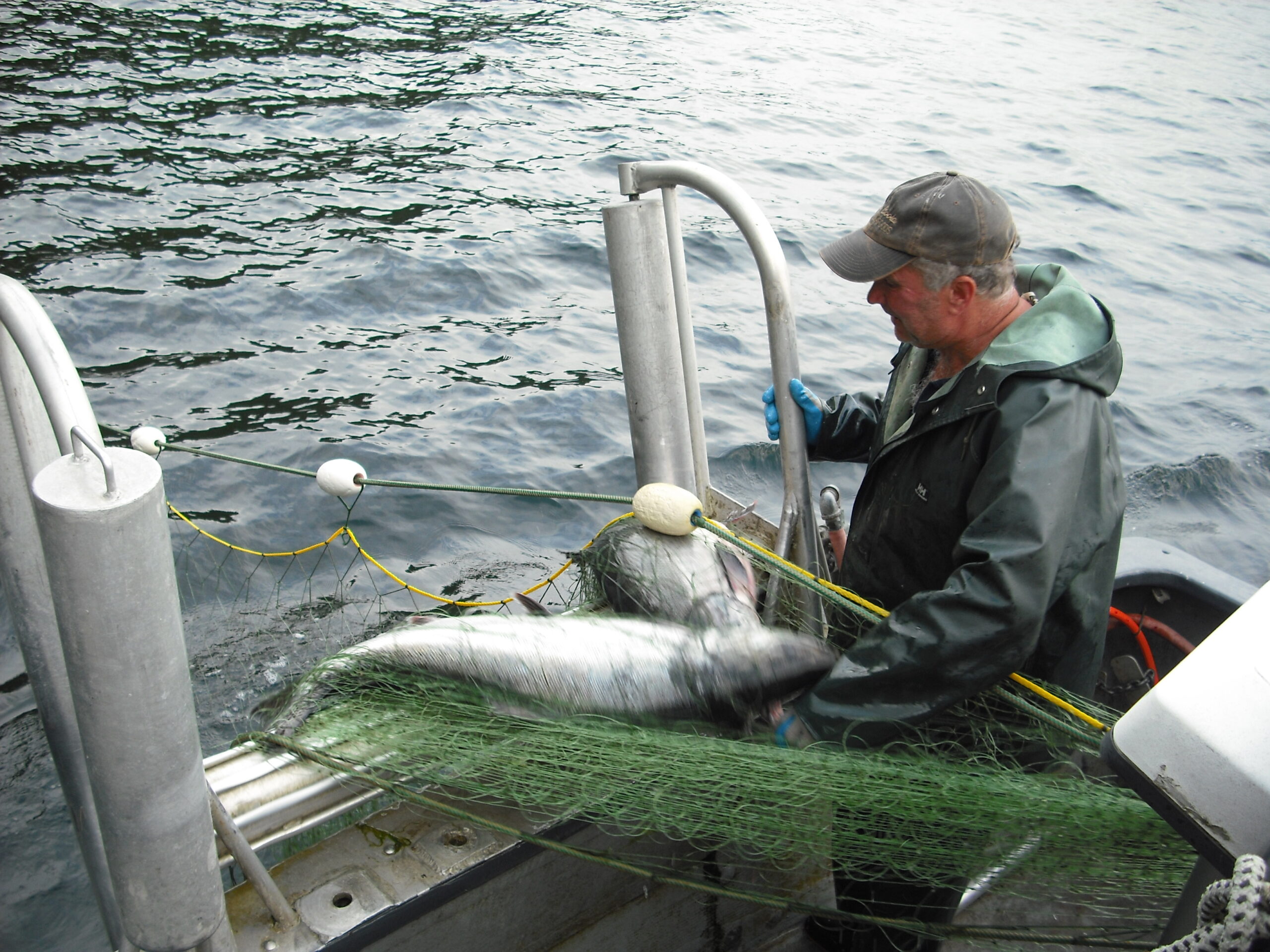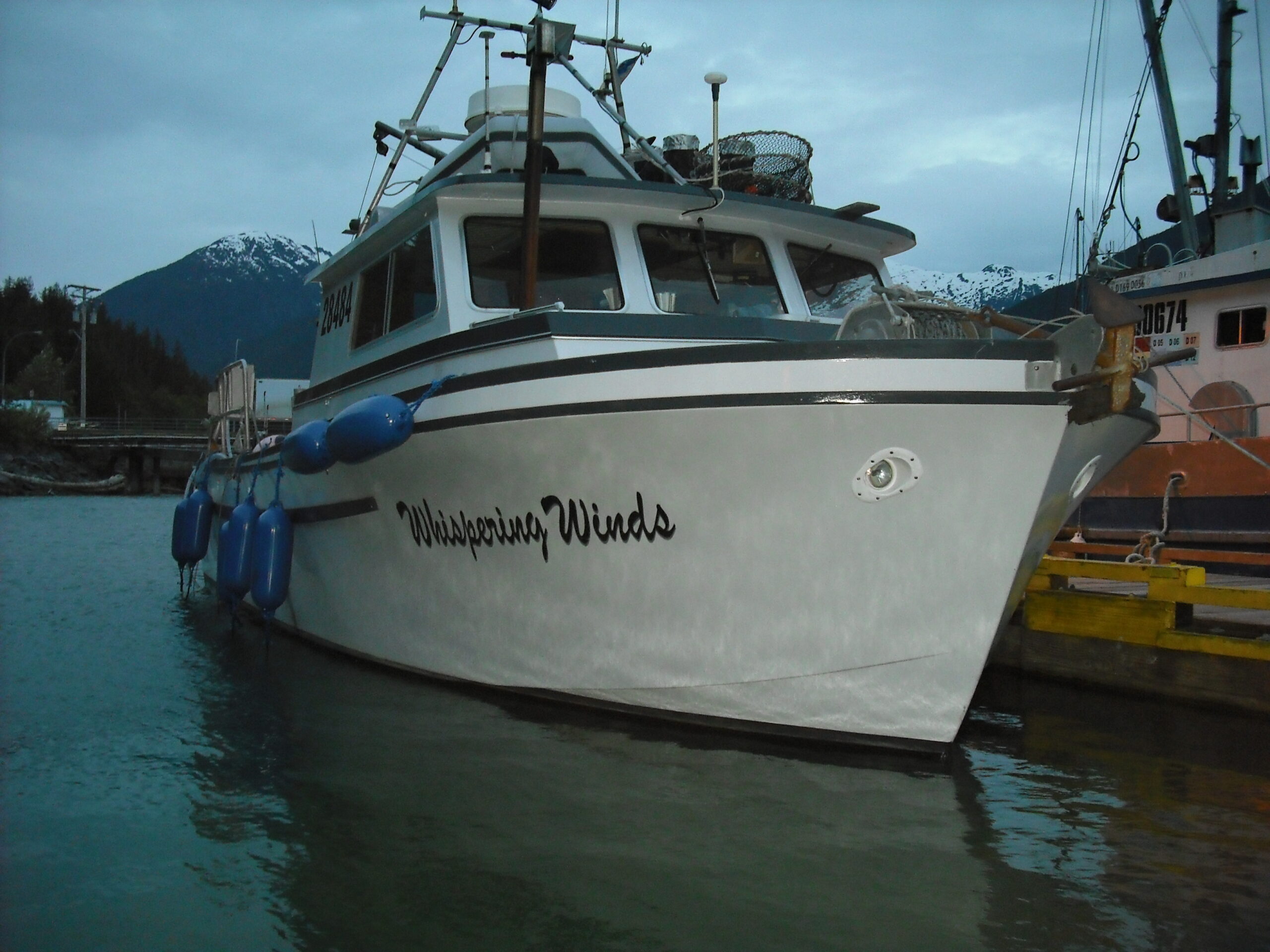By Sage Birchwater —
Tucked away in the specialty fish section of Margetts Meats in Williams Lake are the delectable salmon products of Bella Coola Seafoods. One taste of half-smoked spring salmon fillets will have you hooked. However, the other products like regular spring or chum fillets and steaks or ready-to-eat hot-smoked salmon will have your mouth watering and coming back for more. That’s a guarantee.

Ed Willson landing a spring salmon. Photo: Sage Birchwater
It’s a long way from Williams Lake to the Central Coast waters of Labouchere Channel, Burke Channel, or North Bentinck Arm where Ed Willson spools out his 1,260-foot gill net and catches his fish. However, the western terminus of Highway 20 is Williams Lake’s closest access point to the salt chuck and some of the world’s finest seafood anywhere.
He tells a story of a strange sight he saw a week earlier of a grizzly swimming across Burke Channel to King Island, escorted by two dolphins.
Up Saloompt Road on the sunny side of the Bella Coola Valley, Ed and Sandy Willson process the fish Ed brings home to their state-of-the-art facility. They’ve been operating their provincially licensed Bella Coola Seafoods for over 20 years, and sending their products as far afield as Prince George, Mackenzie, Kamloops, Invermere, and Vancouver.
Ed made a good living as a commercial fisherman when he first got started in 1976. In those days the fishing season ran from April 1 to October, four days a week. Now the season doesn’t start until the beginning of June, with one 24-hour opening per week until July 1. Then the night fishing is cancelled and the opening is shortened to 16 hours a day. There may be two openings a week throughout the summer, depending on the number of fish available and the particular species being targeted.
Ed says the Bella Coola fishing fleet is only a quarter the size it was when he got started 37 years ago, and there’s only 20 per cent of the fish compared to the 70s. What killed the commercial fishing economy was the fish farming industry, established in the early 90s. The flood of farmed fish on the market sent the value of wild fish plummeting. The money paid to commercial fishers for their catch wasn’t enough to sustain them and many went out of business.
Faced with diminishing returns, Ed and Sandy decided they had to add value to their fish. They took a leap of faith and invested in a fish processing facility and Bella Coola Seafoods was born.
Ed says one thing he loves about fishing is the variety.
“You’re always doing something different and not always doing the same damn thing. There are so many different things you’ve got to know how to do.” For one thing Ed hangs his own nets.
“When I was 12 or 14 years old I was the net boy for Margaret Siwallace, Addie Saunders, Annie Schooner, and Mercy Snow. They were the best in the business and I learned how to hang and mend a net from them.”
A week before the start of fishing season, Ed and Sandy sit in the shelter of their Saloompt Road fish processing plant. Ed methodically hangs the lead line on a new nylon gill net, while Sandy spools thick green cord onto an array of net needles.
Out of the blue, Ed suggests I go fishing with him to get a better understanding of what’s going on. A few weeks later I met him at 4:30 a.m. on a Sunday morning. It was mid-June, and we headed to the wharf in Bella Coola where the couple’s 35-foot Carlson gill-netter, The Whispering Wind, was moored. Behind his pickup he towed a trailer carrying four insulated totes of ice.

The Whispering Winds at dawn in Bella Coola harbour. Photo: Sage Birchwater
It seemed strange getting such a jump on the 24-hour opening still 36 hours away, as we motored out of Bella Coola harbour and headed west down Burke Channel. But Ed had his reasons. The opening runs from 6 p.m. Monday to 6 p.m. Tuesday, and Ed wanted to secure a prime fishing spot along one of the channels leading to the open ocean.
The landforms down the channel have names like The Bluffs, Flagpole Point, Big Bay, Green Bay, Bachelor Bay, and Cathedral Point. The locals know them by those names but they are all identified numerically on the charts. By 9 a.m. we anchor in a small cove protected from the prevailing winds and waves blowing up the channel from the ocean.
“I like to come early and read what’s going on,” Ed explains. “This bay is where the high boat has been for the past two weeks. It’s the best fishing hole right here.” He tells a story of a strange sight he saw a week earlier of a grizzly swimming across Burke Channel to King Island, escorted by two dolphins.
“I’ve never seen a grizzly swimming in the salt chuck before.”
Ed reads the signs and ponders where the crest of the run might be. There’s a lot of guesswork and luck involved in fishing, but with nearly 40 years of experience, Ed knows what to look for. The tides, phases of the moon, the colour of the water, and the behaviour of dolphins and seabirds are all factors. And then there’s the weather. Ed picks up the VHF radio microphone and speaks briefly with his brother-in-law and fishing partner, Grant Bittner, anchored in different bay up the channel. Then calls his wife, Sandy, on the satellite phone.
He explains how he and Sandy share all aspects of their fishing and processing business.
“When we started out, I was in the habit of saying ‘I’m going to do this,’ or ‘I’m going to do that.’ Then Sandy told me if I wanted her to help me with this, I’d better start saying ‘we.’ We are working partners. I discuss over the phone with her, where to go to fish.”
Ed heads for his bunk in the fo’c’sle of the boat to catch up on some badly needed sleep after long days processing fish and the early morning departure. He offers me the use of the skiff to jig for cod or rockfish, if I desire.
A spectacular thunder and lightning storm blows into the channel cresting whitecaps in the open water. I waken Ed as the action of the winds and waves has loosened the anchor and we are drifting uncomfortably close to the rocky shore. Ed resets the anchor and sets a shoreline to keep The Whispering Wind pointed into the weather, then calls Grant on the VHF. The storm is blowing heavy down Labouchere Channel too, Grant informs him.
The storm abates and we spend a pleasant evening chowing down Ed’s great cooking, and planning the next day’s activity.
At 6 p.m. sharp Ed spools his net across the bay, secured to buoys at both ends. The net forms an arc in the tide as Ed patrols it with The Whispering Wind, and retrieves fish snagged in the webbing. We make three or four more sets before nightfall, then rest until first light.
An aluminium revival box attached to the starboard gunwale beside the net drum is designed to revive steelhead or coho caught in the net. Fortunately, we never had to use it.
As our luck tapers off, Ed speculates the main run might be further up the chuck. The next morning we try a new location and Ed’s intuition pays off. We get back to the wharf that evening “high boat” of the fleet, with the most number of fish.
Besides processing their own catch, Ed and Sandy buy fish from half a dozen other fishers who produce the high quality of fish they demand.
“We look for firm fish that are looked after properly,” Ed explains. “If there’s a bunch of blood and the fish are limp, then they haven’t been looked after. They would look like hell in the package.”
Last year they purchased 11,000 pounds of spring salmon from other fishers, paying more for them than the commercial buyer. This helps sustain the local fishing economy.
At their fish processing plant the next day, Ed and Sandy are both up at first light, cleaning, cutting, and packaging the fish to ensure optimum quality.
The fish they don’t have time to process right away are flash frozen and glazed in sugar water to preserve their freshness. The whole glazed fish are wrapped in plastic in big totes and kept frozen at -25 degrees Celsius.
As Ed cuts up the steaks and fillets, Sandy vacuum seals them in attractive packaging. They get the smoker going and hot-smoke the waste pieces into ready-to-eat products. “We utilize everything,” Sandy says. “Nothing goes to waste.”
Besides producing their own Bella Coola Sea Foods delicacies, Ed and Sandy custom cut other people’s fish, including those caught in the native food fishery. “The custom stuff is all written down,” Ed explains. “The paper trail documents and backs up everything.”
Stamped “not for resale” they won’t end up in Margetts Meats, but they’re just as delectable.
Sage Birchwater moved to the Cariboo-Chilcotin in 1973. He spends his time freelancing and authoring books, hanging out with his dog, gardening, and being part of the rich cultural life that is the Cariboo Chilcotin Coast.
